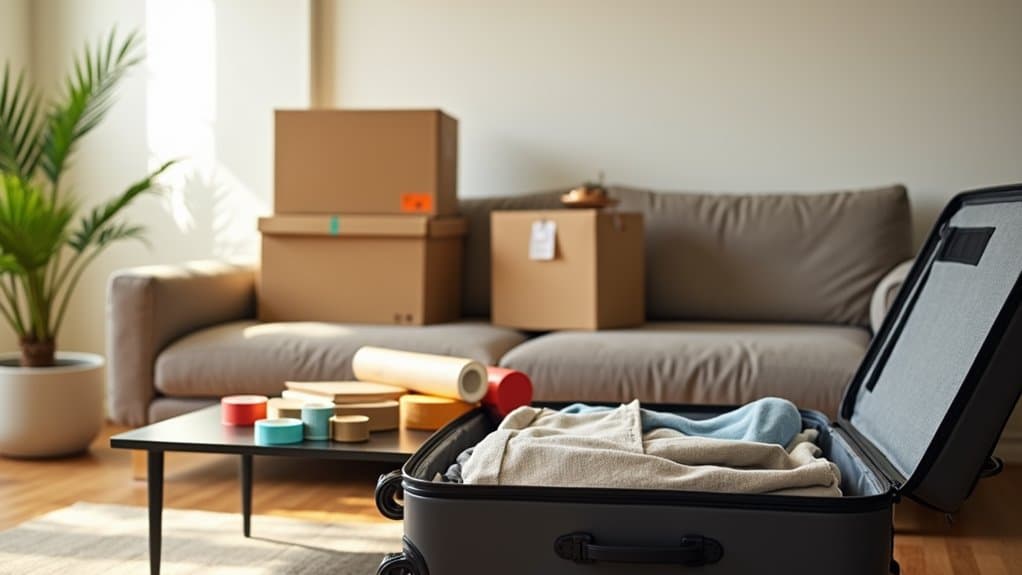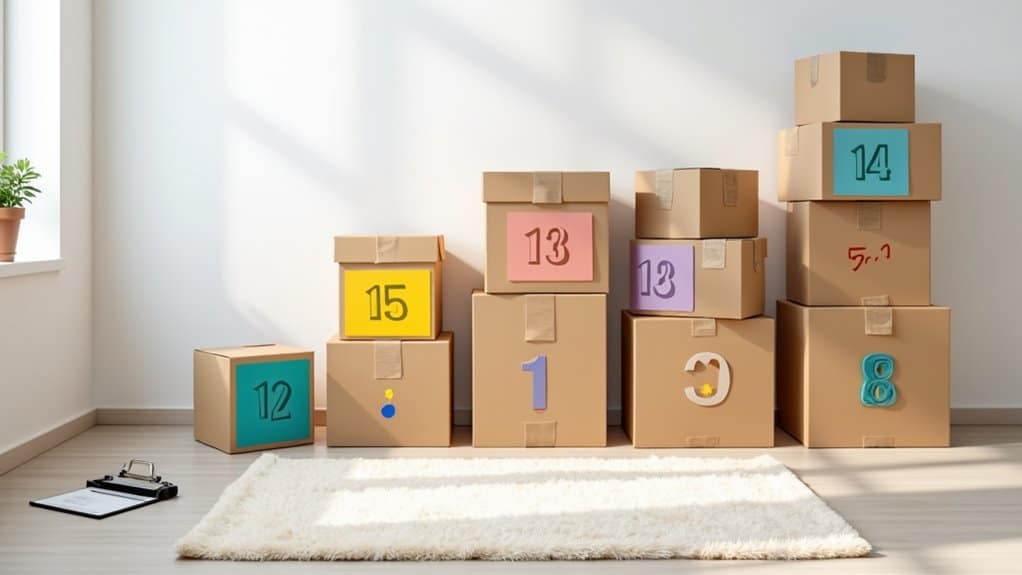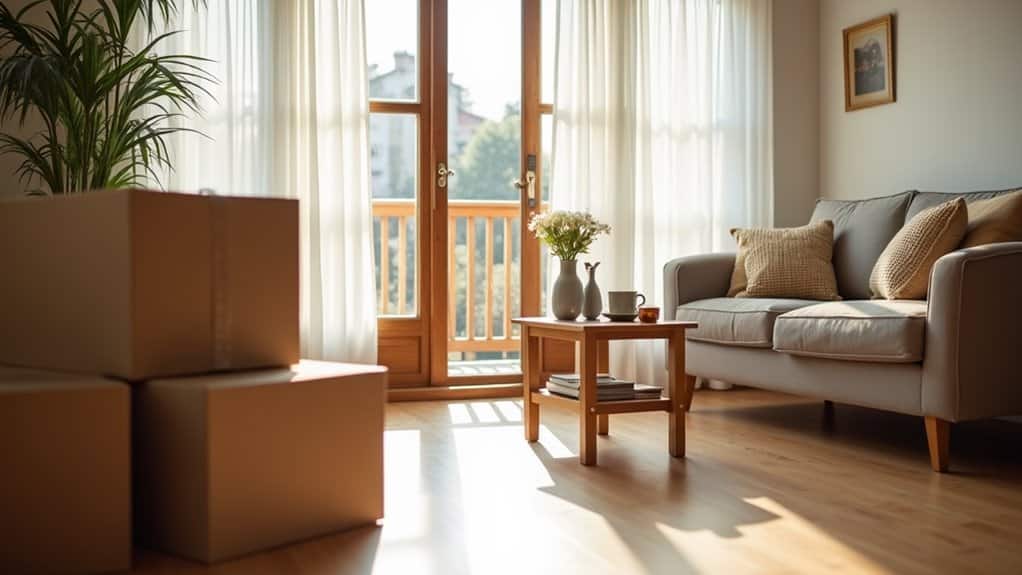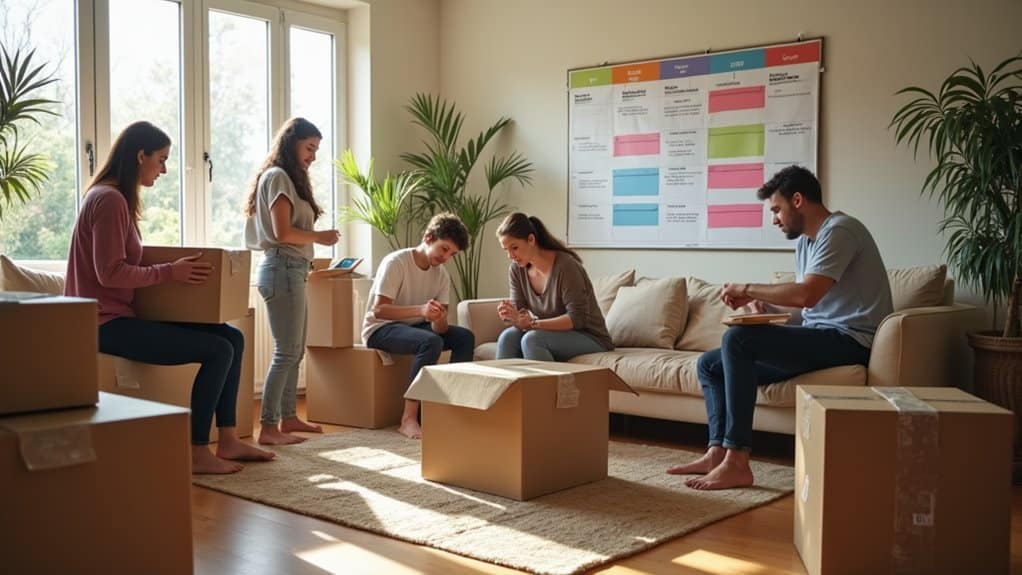
Best Practices for Moving House With Minimal Downtime
To move house with minimal downtime, start your preparations early. Begin at least eight weeks before the move by creating a moving binder and checklist. Declutter your home by sorting items into categories: keep, donate, sell, or discard. When packing, opt for smaller boxes for easier transport, and clearly label them by room and contents for quick unpacking. Prioritise packing essentials and allocate tasks among your team. Tackle one room at a time to make the process smoother. Stay organised and keep communication open throughout. Following these practices will help ensure a more straightforward move, and there are additional tips to explore for an even easier experience.
Key Takeaways
- Start planning at least eight weeks in advance by creating a moving checklist and timeline to avoid any last-minute stress.
- Declutter and sort your belongings six weeks before the move. This gives you time to sell or donate items, ultimately reducing your moving costs.
- Gather your packing materials four weeks ahead of time to ensure you have everything needed for efficient packing.
- Consider hiring professional movers to streamline the logistics. Always check their credentials and clearly communicate your requirements for a smooth transition.
- When unpacking, focus on one room at a time, prioritising essentials first so you can quickly settle into your new home.
Pre-Move Preparation
Pre-move preparation is crucial for a seamless relocation. Start by creating a moving binder to keep all your documents in order. This should include quotes from removal firms, receipts, important paperwork, and a room-by-room inventory to track your belongings.
As you prepare, develop a detailed moving checklist and packing timeline to help you stay organised.
Begin decluttering at least six weeks before your move. Go through each room and sort items into keep, donate, sell, or discard categories. You might consider holding a car boot sale or listing unwanted items on websites like eBay or Gumtree.
Four weeks before moving day, gather packing materials such as boxes, tape, and bubble wrap. Pack non-essential items first, like seasonal decorations or extra kitchenware, and label each box clearly with its contents and the room it belongs to. This will make unpacking much easier.
Finally, one week before the move, confirm your arrangements with the removal firm and prepare essentials like toiletries and snacks. It is also wise to establish a comfortable budget to ensure you are financially prepared for your moving expenses.
Don't forget to clean your old home and ensure the utilities are set up at your new place. Following these pre-move preparations will help ensure a hassle-free relocation.
Starting Early
Starting early is crucial for a smooth move, as it allows you to create a clear timeline. By giving yourself enough time to pack, you can sort through your belongings methodically, which helps to minimise last-minute stress. This proactive approach not only simplifies the moving process but also prepares you for a successful transition into your new home. For example, tackling one room at a time can make the task feel less overwhelming. Additionally, starting early gives you the advantage of securing a mortgage with optimal market conditions that can lead to better pricing and negotiation opportunities. Moreover, beginning your preparations at least 1 month before moving ensures you have ample time to address any special concerns that may arise.
Planning Timeline Importance
A well-organised moving timeline is crucial for a smooth transition to your new home. By breaking the moving process into manageable tasks, you ensure that everything runs efficiently, reducing last-minute panic and stress.
Starting early allows you to tackle each job at a comfortable pace, avoiding the chaos often associated with moving. Aim to start planning at least eight weeks before your moving date. Additionally, booking removal company early helps secure your preferred date and prevents last-minute complications.
Create a timeline that divides tasks into weekly steps, prioritising them by urgency and importance. This approach helps you declutter your belongings, sort them into categories, and gather necessary packing supplies without feeling overwhelmed. Organizing important documents is also a key aspect to address during this time.
Booking moving services early is essential to avoid last-minute complications, and it gives you plenty of time to arrange utility setups in your new home.
Moreover, a well-structured timeline provides a buffer for any unexpected delays or issues, ensuring you don't overlook any important steps.
Early Packing Benefits
Once you've set a solid moving timeline, early packing provides several benefits that can significantly ease your moving experience. Starting early can help you minimise last-minute stress and ensure a smoother transition.
| Benefit | Description | Impact on Moving Day |
|---|---|---|
| Reduces Last-Minute Stress | Packing bulky items first saves time and effort. | Less chaos on moving day. |
| Facilitates Cleaning | Allows for thorough cleaning under furniture. | Ensures a dust-free environment. |
| Aids Organisation | Packing room-by-room promotes better organisation. | Easier unpacking later on. |
| Supports Financial Efficiency | Selling or donating items can help finance your move. | Lowers overall moving costs. |
| Enables Supervision | More time to oversee the moving crew on the day. | Ensures everything runs smoothly. |
With a well-planned packing schedule, you can declutter effectively, keep your new home tidy for viewings, and prioritise essential items. Early packing not only helps manage stress but also sets you up for a successful moving day. Additionally, it provides an opportunity to evaluate belongings and decide what to keep or let go, further simplifying the moving process. So, don't delay—start packing early and enjoy a seamless move to your new home!
Creating a Timeline

Creating a timeline for your move is essential for staying organised and ensuring nothing gets overlooked. Start by identifying key tasks and deadlines, allowing for some flexibility in case adjustments are necessary.
Begin your planning eight weeks in advance: research moving companies and set a budget. During this phase, it's important to research potential red flags associated with moving companies to make an informed decision.
At four weeks to go, focus on tracking milestones by making an inventory of items to move and start packing non-essential belongings.
In the final two weeks, concentrate on packing the remaining items by room and confirming important moving details, such as any necessary reservations. This stage is crucial for keeping everything on track and avoiding last-minute surprises.
As moving day approaches, finalise your checklist and pack the essentials you'll need straight away. This timeline will help you stay focused and reduce stress as you can easily monitor your progress.
Purging Unwanted Items
As you get ready for your move, clearing out unwanted items can significantly ease the process. Instead of sorting by room, categorise your belongings. This ensures a thorough approach. Start with simpler categories like old clothes or tech gadgets to kick off your decluttering.
Make a list of categories—furniture, clothing, books, and so on. Use a piling system to sort items into five groups: keep, sell, donate, recycle, and bin. This method makes decision-making easier.
When deciding what to keep, consider if the item is useful, in good condition, or brings you joy.
Try the 20/20 rule: if an item can be replaced for under £20 within 20 minutes, think about letting it go. Look up local charities for donations or recycling centres for electronics.
If you have items worth selling, plan garage sales or online listings ahead of time.
Packing Strategies

When packing, using smaller boxes can greatly assist in managing heavy items and keeping everything organised.
It's vital to label each box clearly so you know what's inside and where it belongs in your new home. This straightforward strategy not only saves time but also simplifies the unpacking process.
For instance, putting all kitchen items in one box and marking it accordingly can help you settle in quicker.
Small Box Advantages
Small boxes provide numerous advantages that make them essential for any moving plan. Their compact design improves packing efficiency and ensures durability, which is crucial for safeguarding your belongings during transit.
Here are three main benefits of using small boxes:
- Stronger Construction: Small boxes are less likely to tear due to their robust walls, making them ideal for fragile items that require extra protection.
- Versatility and Ease of Use: Small boxes are lightweight and easy to carry, perfect for transporting in vehicles. You can fill them to capacity without worrying about them becoming too heavy.
- Cost and Space Efficiency: They're generally more affordable than larger boxes and help maximise space in a removal van. You can stack them neatly and fill in gaps, reducing the number of trips needed.
Although packing and unpacking may take a bit longer with small boxes, their benefits in efficiency and durability make them invaluable for a hassle-free move.
Labeling Importance
Proper labelling is crucial for a smooth moving experience. It minimises the risk of loss or damage, simplifies unpacking, and saves you time. By using effective labelling strategies, you can navigate the chaos with ease. Consider the following table when labelling your boxes:
| Label Element | Purpose | Best Practices |
|---|---|---|
| Room Name | Directs boxes to the correct rooms | Use a clear, large font |
| Contents | Identifies what's inside | Be specific to ease unpacking |
| Special Handling | Alerts movers to handle items carefully | Use bold markers for visibility |
| Priority Indicators | Highlights essential items | Use symbols or colours for quick reference |
| Colour Coding | Assigns colours for room identification | Keep a colour key for reference |
To ensure labels last, use permanent markers and place them where they're easily visible. Avoid overloading boxes to prevent damage to labels. Following these best practices will enhance organisation and reduce stress during your move.
Using Small Boxes
Using small boxes can significantly streamline your moving process. They offer several advantages that make your move more efficient. Here are three key benefits:
- Strength and Protection: Smaller boxes are generally sturdier due to their shorter walls, providing better protection for your belongings.
- Easy Handling: When full, small boxes are easier to carry and less likely to become too heavy, making it simple for anyone to lend a hand during the move.
- Space Optimisation: Their compact size means they can be packed efficiently into removal vans, maximising space and reducing the number of trips required.
Although you'll need more boxes to accommodate the same amount of items, the benefits of small boxes far outweigh this drawback.
They're also environmentally friendly, often made from recycled materials. Packing with small boxes encourages organisation, allowing you to sort items effectively.
Just remember, they may not be suitable for larger objects, so a mix of box sizes is usually advisable.
Ultimately, using small boxes sets you up for efficient packing, making your moving day smoother and more manageable.
Labeling and Tracking Boxes

When labelling your boxes, clear descriptions are crucial for quick identification when unpacking.
Using a colour-coding system can simplify things by assigning specific colours for each room. For instance, use blue for the kitchen and red for the bedroom.
This way, you can easily sort and find your belongings in your new home.
Clear Box Descriptions
Labeling and tracking your boxes effectively can simplify the moving process, making unpacking easier and more organised.
Clear box descriptions are vital for knowing exactly what's inside each box. Here are three key strategies to improve label clarity:
- Be Specific: Write detailed itemised lists directly on the label. Instead of vague terms like "Kitchen Items," use "Pots and Pans." This allows you to find what you need quickly.
- Include Room Information: Clearly indicate the destination room on each box label. This helps your movers and makes unpacking more straightforward.
- Utilise Inventory Sheets: Create a comprehensive inventory list for each room. Note not just the box contents but also the condition of items for possible insurance claims.
Color-Coding System
A colour-coding system can simplify your moving process and reduce the usual chaos. By assigning distinct colours for each room—like red for the kitchen, blue for the living room, and green for bedrooms—you can enhance organisation and lower stress.
Use brightly coloured markers or tape to label each box clearly. This approach not only saves time when unpacking but also allows for quick organisation in your new home. Movers can easily direct boxes to their designated areas based on colour, enabling you to unpack multiple rooms simultaneously.
To improve visibility, place large stickers or labels on each box and display your colour key at the entrance of your new home. Make sure to communicate the colour-coding system to your movers and provide them with a copy of the colour key.
This ensures everyone understands the plan, reducing confusion. By taking a systematic approach to labelling and tracking boxes, you'll find that moving can be manageable and much less stressful.
Moving Logistics
Moving logistics are crucial for a seamless transition to your new premises. To simplify the process, develop a solid plan that includes a moving checklist and logistics software. Here are three essential steps to consider:
- Conduct a Thorough Assessment: Review your current facilities to spot any challenges. This proactive approach helps you anticipate potential issues before they occur.
- Create a Detailed Moving Plan: List tasks, deadlines, and budget needs. Utilise project management tools like Teams or SharePoint to monitor progress in real-time, ensuring everyone is well-informed.
- Designate a Move Team: Allocate responsibilities among team members for tasks such as securing loading bays and establishing communication channels. Regular meetings will keep everyone synced and updated.
Choosing Moving Options

When deciding on your moving options, think about whether you want to do it all yourself or hire professional movers.
A DIY move can save you money, but it demands a lot of time and effort.
On the other hand, hiring professionals offers convenience, though it can be pricier.
Consider your budget, the amount of work involved, and your personal preferences to determine what suits you best for your move.
DIY Moving Considerations
Selecting the right DIY moving option is crucial for a smooth relocation experience. With various choices available, it's important to match them to your budget and specific needs.
Here are three essential factors to consider when choosing a truck rental:
- Truck Size: Ensure you hire a truck that fits your belongings. A truck that's too small may require multiple trips, while a larger one could lead to unnecessary expenses.
- Equipment and Services: Opt for rentals that provide useful equipment like trolleys and blankets. Some hire companies also offer additional services, such as help with loading and unloading, which can save you considerable time and effort.
- Insurance Options: Check the insurance coverage with your truck rental to protect against potential damage during transport. Knowing you're insured can provide peace of mind throughout your move.
Hiring Professional Movers
Hiring professional movers can significantly simplify your relocation process. When selecting a mover, it's crucial to do your research. Verify the mover's licence to ensure they're authorised for interstate moves.
Check their complaint history through the relevant regulatory bodies and consult the British Standards Institution (BSI) for additional insights.
Next, obtain written quotes from several movers, ensuring they conduct thorough assessments of your belongings. This will help you compare services and estimate costs more accurately.
Use a detailed inventory list to track your items, and consider clear labelling or colour-coding for easy identification during the move.
Insurance coverage is vital, so confirm what the mover offers regarding liability and coverage for valuable items. Familiarise yourself with the claims process in case of loss or damage.
Finally, maintain clear communication with your chosen mover about your expectations and requirements. Consider forming a move team within your organisation to coordinate tasks efficiently.
Planning, including scheduling the move during quieter times, can help minimise disruption. With the right professional movers, you can ensure a smooth transition to your new home.
Unpacking and Setup
Unpacking and Setting Up Your New Home
Once you've moved into your new home, the unpacking can feel a bit daunting. To make the process easier and more efficient, try these straightforward steps:
- Tackle One Room at a Time: Focus on one room before moving on to the next. This not only reduces stress but also gives you a sense of achievement as each space comes together.
- Sort and Label Your Boxes: Before you start unpacking, sort your boxes by room and label them clearly. This will save you time and hassle by helping you find what you need without digging through everything.
- Create a Central Holding Area: Designate a space in your home for all the boxes. This temporary area will keep things tidy and allow you to concentrate on unpacking the essentials first.
When unpacking, prioritise the items you'll need immediately, such as toiletries for the bathroom or basic kitchen equipment.
Keep similar items together to make organising easier as you go along.
Don't forget to flatten packing paper and break down empty boxes to keep your space tidy.
Prioritizing Essentials

Unpacking your new home can feel daunting, but knowing what to focus on makes it simpler. Start by preparing an essentials box with items you'll need immediately. This should include toiletries, a change of clothes, bedding, and any necessary medications.
Don't forget immediate needs like snacks and important documents to help you settle in comfortably.
When packing your essentials box, consider your family's specific needs. If you have children, include nappies and wipes. For pets, pack their food and bowls to keep them comfortable during the transition.
It's also wise to include basic tools like a screwdriver, scissors, and a utility knife, which can be handy for setting up your new space.
Additionally, think about adding sentimental items that offer comfort during this time. By prioritising these essentials, you'll reduce downtime and ensure a smoother move into your new home.
A well-organised essentials box is crucial for making your first few days as stress-free as possible.
Reducing Stress
Moving to a new home can be stressful, but with careful planning and proactive strategies, you can reduce that tension.
Here are three effective practices to help manage stress:
- Create a Detailed Plan: Make a moving plan that outlines your tasks and timelines. Knowing what needs to be done and when can help you avoid last-minute stress.
- Practice Mindful Breathing: Take short breaks during the busy moving process to focus on your breathing. This simple technique can help ground you and alleviate feelings of being overwhelmed.
- Seek Emotional Support: Reach out to friends or family for help. Sharing your worries and experiences can provide comfort and a fresh perspective.
Distributing Tasks

Distributing tasks effectively can make your move smoother and less daunting. By using smart delegation techniques and encouraging collaboration among friends and family, you can share the workload and maintain efficiency.
Here's a straightforward table to help you organise task distribution:
| Task | Assigned Person | Deadline |
|---|---|---|
| Pack kitchen items | John | 2 days before |
| Label boxes | Sarah | 1 day before |
| Move furniture | Mike and Emily | Moving day |
| Organise garage items | Grandma | 3 days before |
| Finalise utility setups | You | Moving day |
Start planning early, establish a timeline, and assign specific tasks to different people. Make the most of your resources; consider hiring professional organisers if your budget allows. Don't hesitate to ask friends and family for help—this not only reduces stress but can also make the process more enjoyable. Remember to pack non-essential items first and use clear labels to keep everyone informed.
Staying Organized
A well-organised move can significantly reduce stress and chaos. By staying organised, you can streamline both your packing and unpacking processes.
Here are three essential strategies:
- Create a Moving Binder: Gather all your important documents such as utility details, medical records, and moving contracts in one easy-to-access place. This will be your main resource throughout the move.
- Implement Colour Coding: Assign a specific colour for each room and label your boxes accordingly. This simple method makes it much easier to identify where items should go when unpacking.
- Plan for Your First Night: Pack a "First Night" box with essentials like bedding and toiletries. This ensures you have everything you need to settle in quickly without having to search through multiple boxes.
Frequently Asked Questions
How Do I Handle Moving With Pets During the Process?
When moving with pets, it's essential to prioritise their safety and comfort. Keep them in quiet areas away from the chaos during the move, and transport them securely in a suitable pet carrier. Try to stick to their usual routines, such as feeding and walking times, to help them adjust to the new environment. Ensure you have all the necessary preparations in place for your pet's relocation, such as updating their microchip details and having their favourite toys or blankets on hand.
What Should I Do With Perishable Food Before Moving?
Before moving, make a list of perishable food items to help you manage disposal. Use perishables in your meals, share them with friends or neighbours, and reduce your shopping to minimise waste during the move.
How Can I Manage My Children During the Move?
To manage your children during the move, consider arranging childcare for moving day and plan some engaging activities to keep them entertained. Give them age-appropriate tasks, such as packing their toys or sorting out their clothes. This keeps them involved and motivated, helping to reduce stress for everyone.
What Are the Best Strategies for Moving Fragile Items?
Did you know that approximately 30% of breakages happen during moves? To avoid this, use effective packing techniques such as bubble wrap for cushioning. Carefully wrap each fragile item and secure them in sturdy boxes to ensure safe transport. For example, place dishes vertically, like records, and use crumpled paper to fill any gaps. This will help prevent them from shifting and breaking.
How Do I Ensure My Mail Is Forwarded to the New Address?
To ensure your mail is forwarded to your new address, submit a change of address request through the Royal Mail website or visit your local post office. This ensures you receive all important correspondence without any disruption. For example, if you're expecting a bank statement or a parcel, this simple step will keep everything on track.
Conclusion
Moving house doesn't have to be a daunting task. By preparing in advance, setting a clear timeline, and decluttering, you can simplify the process and minimise downtime. Start by prioritising essential items and sharing tasks with family or friends to alleviate stress. Staying organised is crucial—think of it as laying a solid groundwork for your new home. With these best practices, you can make your move smoother, turning what could be a hectic experience into a manageable one.


